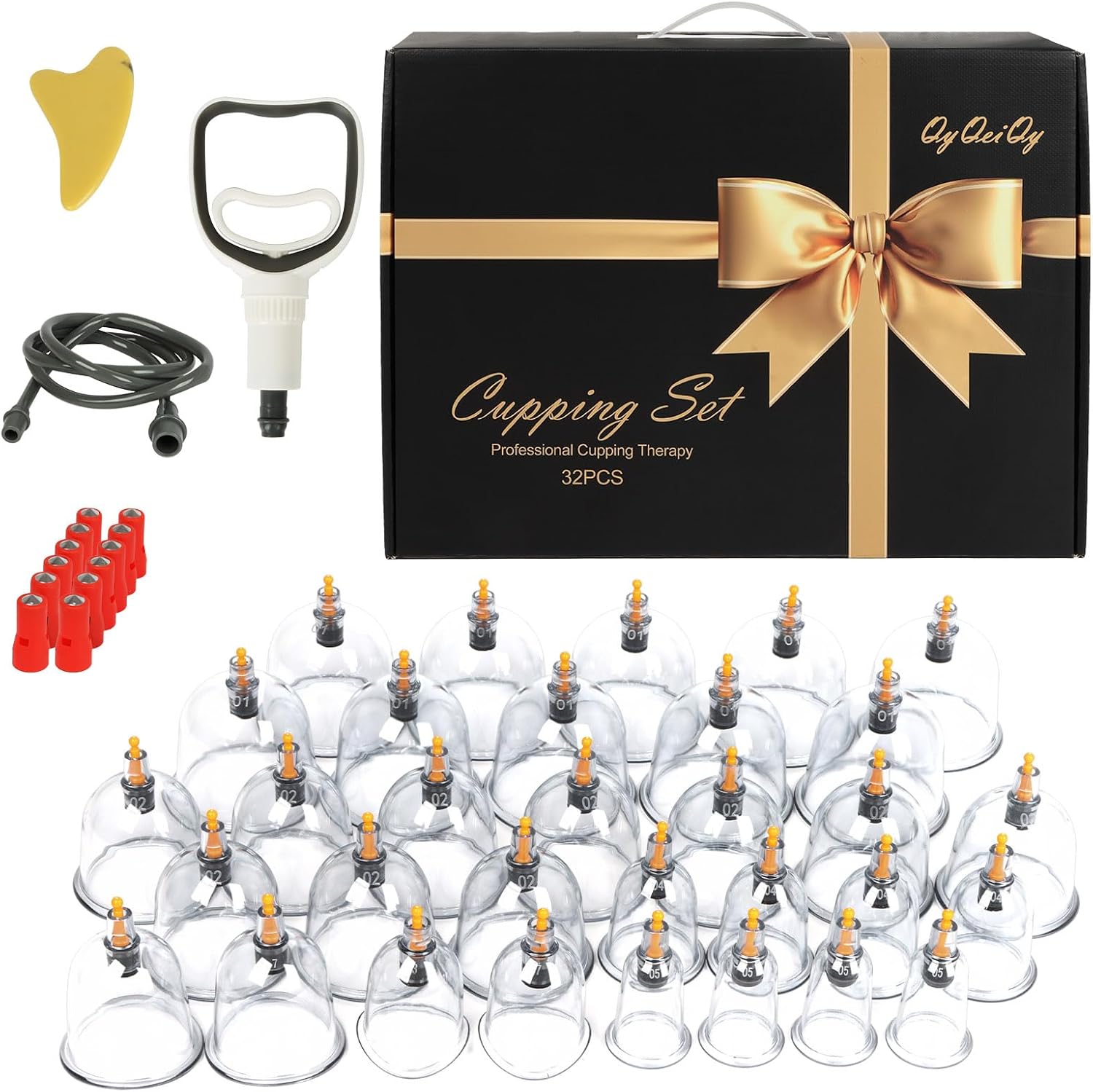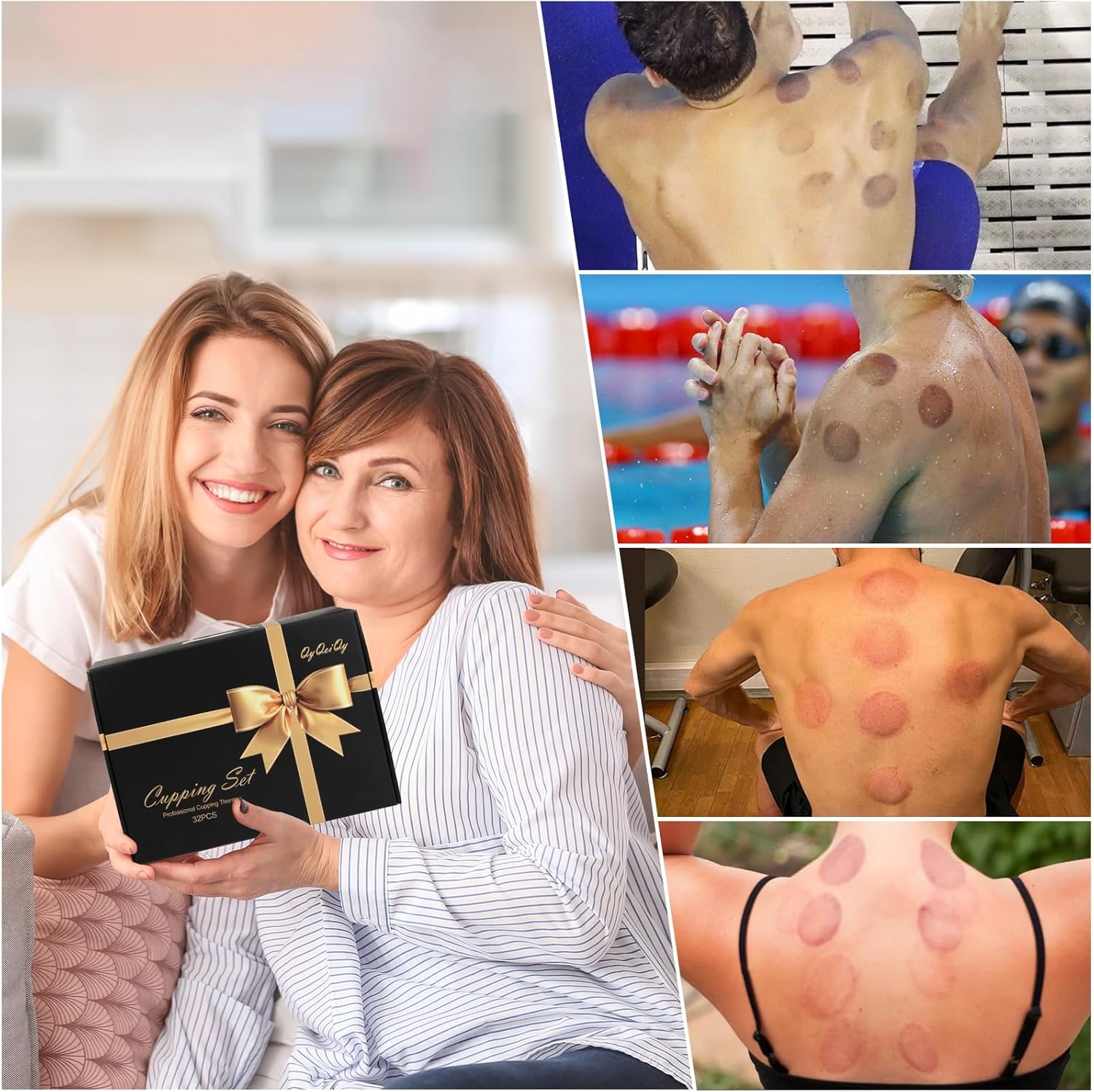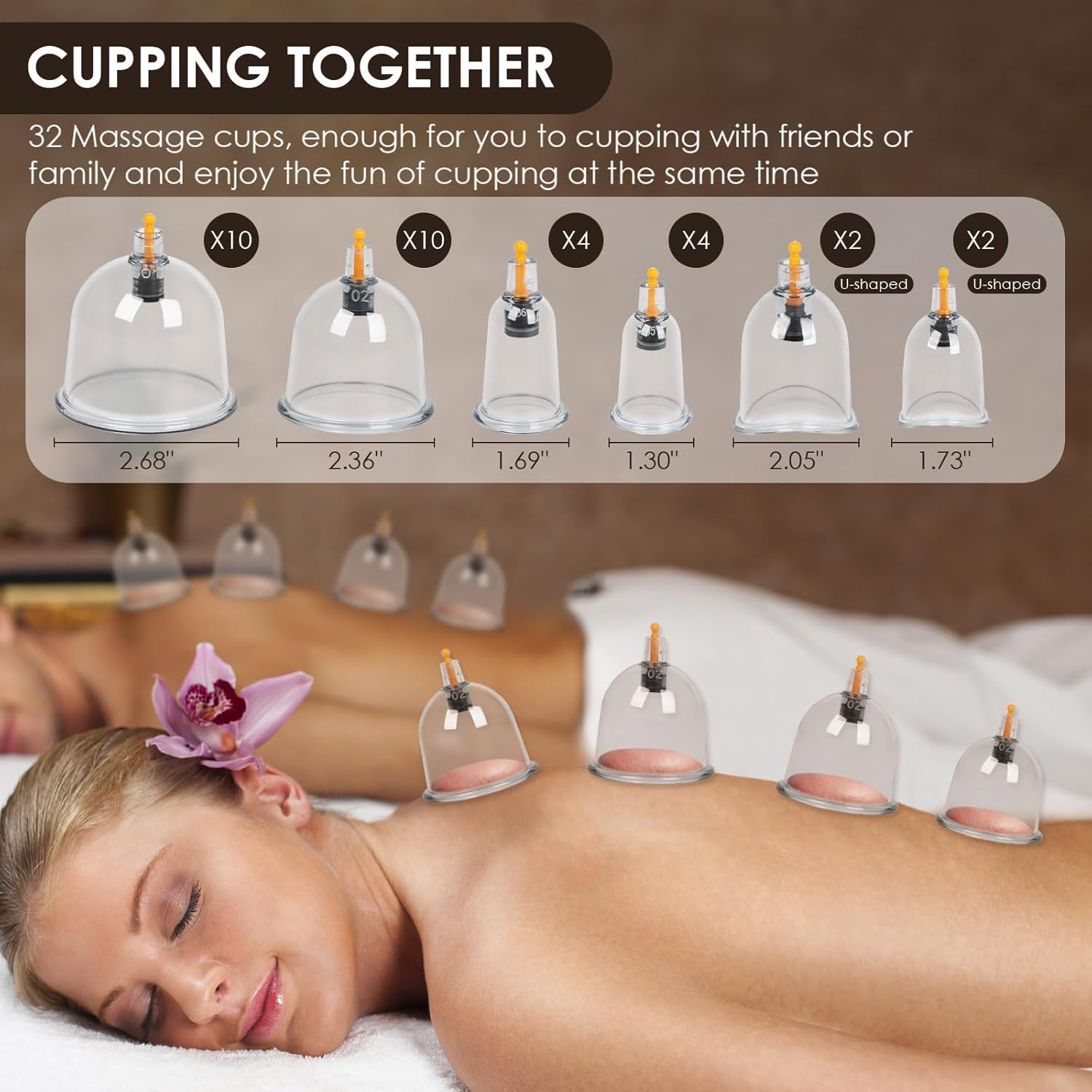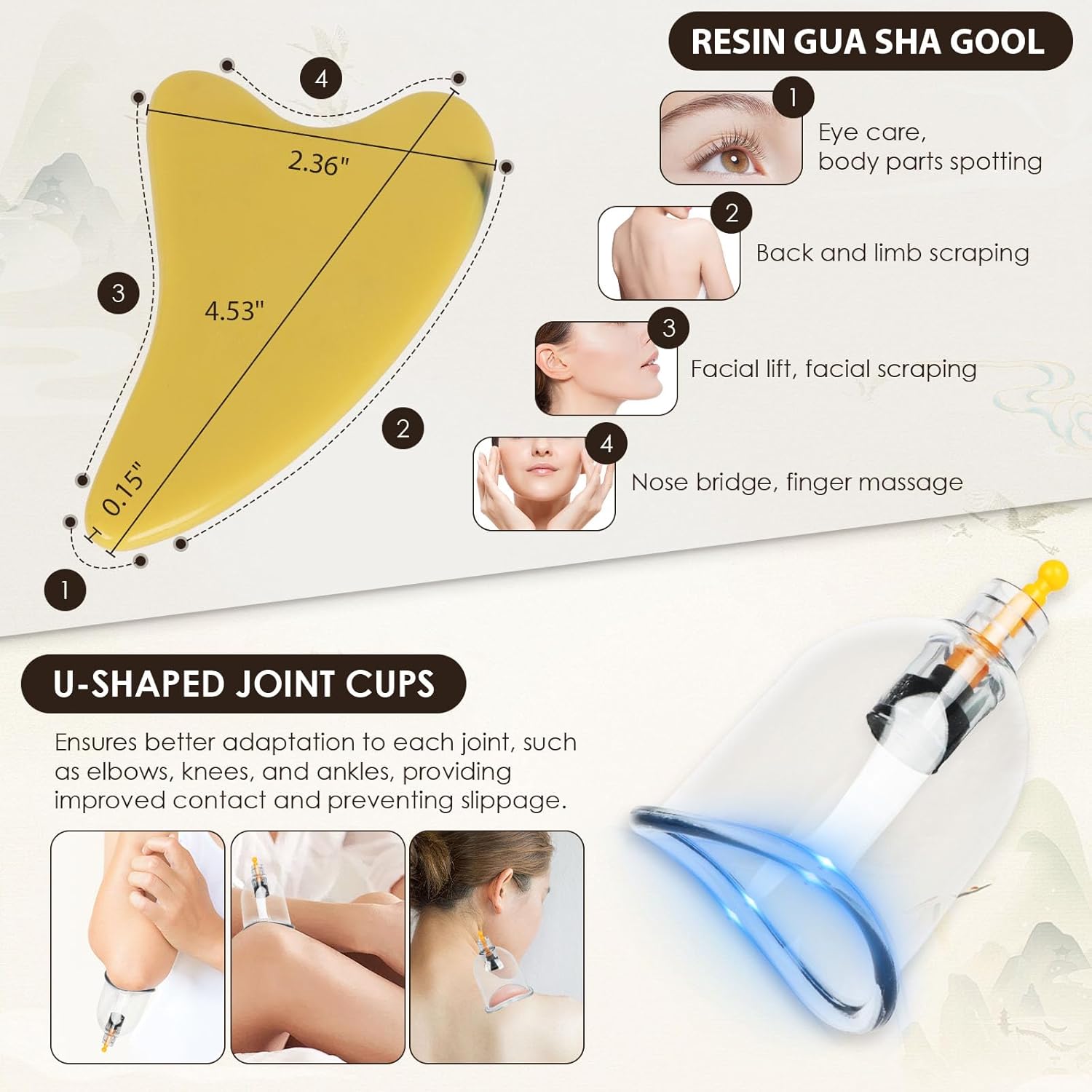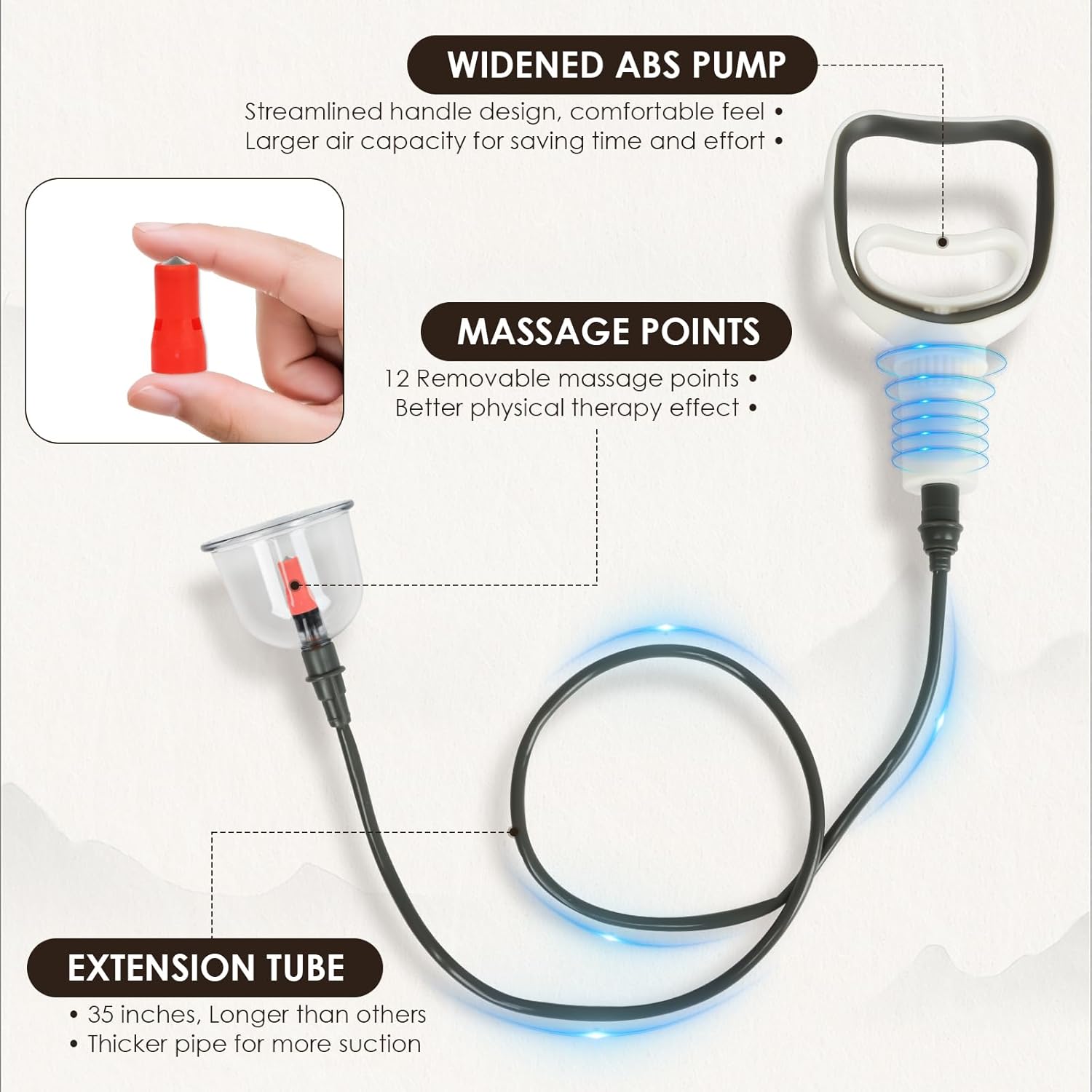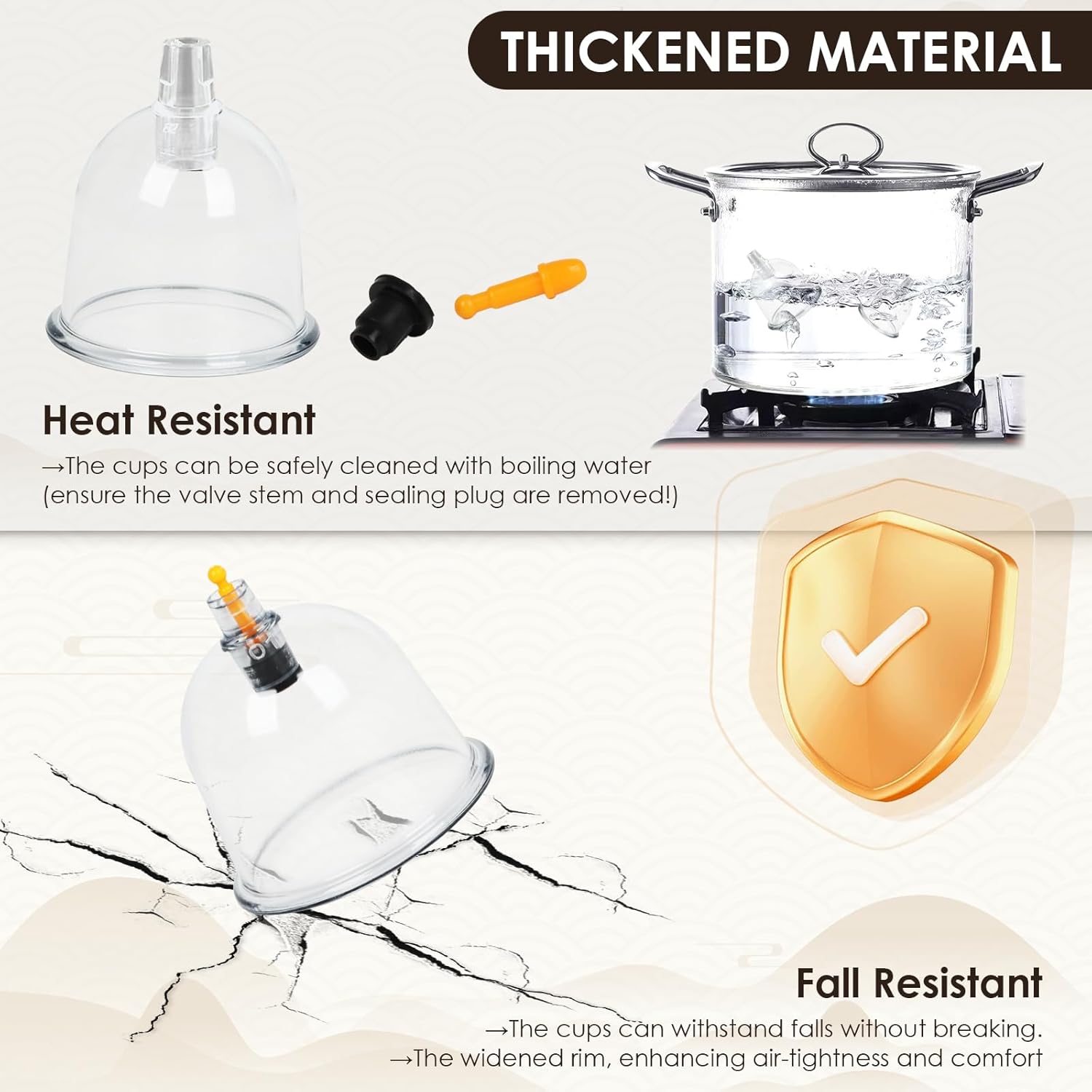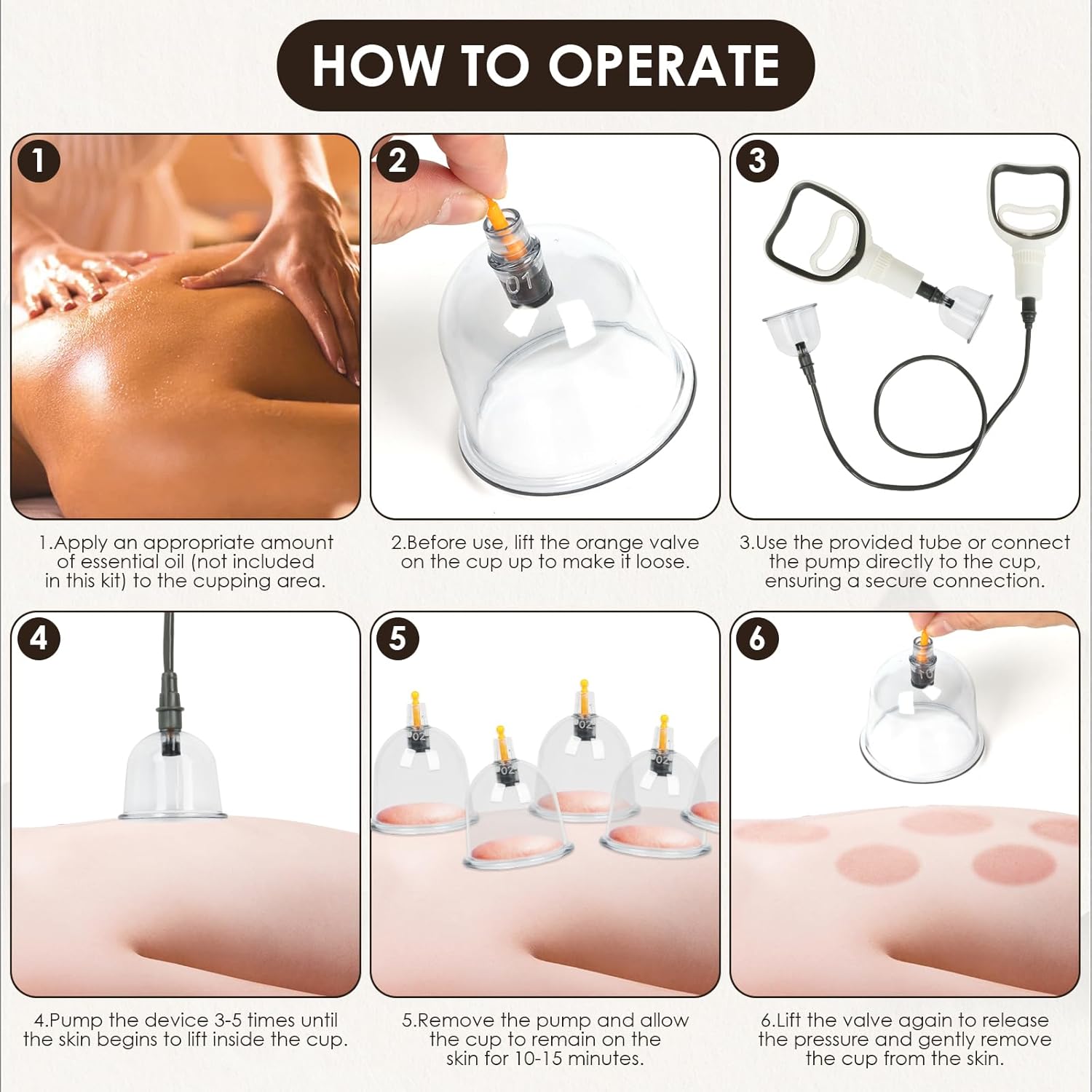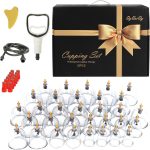
Cupping Kit for Massage Therapy – 32 Review cup manual – Oemiu
Cupping Kit for Massage Therapy – 32 Review Cup Manual
Cupping therapy, an ancient practice that dates back thousands of years, has seen a resurgence in popularity in recent years. From athletes seeking to enhance performance and recovery to individuals seeking relief from chronic pain and muscle tension, the benefits of cupping are becoming increasingly recognized. At the heart of this therapy lies the cupping kit itself. This comprehensive review will delve into the world of cupping kits, focusing specifically on the “32 Cup Manual” variety, exploring their components, benefits, and how to effectively use them for massage therapy. We’ll also address some common concerns and questions surrounding this intriguing and effective treatment modality. Using a proper cup manual is essential to fully understand how these tools can be used safely and effectively.
Understanding Cupping Therapy: More Than Just Circular Marks
Cupping therapy is more than just leaving those distinctive circular marks on the skin. The fundamental principle behind cupping is to create a vacuum within a cup that is then applied to the skin. This suction pulls the skin and underlying tissues upwards, which has several physiological effects. Firstly, it promotes increased blood flow to the area. This localized increase in circulation helps to nourish tissues, remove metabolic waste products, and deliver oxygen and nutrients essential for healing and repair. Think of it as a targeted delivery system for the body’s natural healing mechanisms. Secondly, cupping can help to release muscle tension and adhesions. The lifting action of the cup can gently separate layers of tissue that have become stuck together, improving range of motion and reducing pain. This is particularly beneficial for individuals with tight muscles, scar tissue, or fascial restrictions. Thirdly, cupping can influence the nervous system. The stimulation of sensory nerves in the skin can have a calming effect, reducing pain signals and promoting relaxation. This can be particularly helpful for individuals experiencing chronic pain conditions or anxiety. It’s also important to understand the different types of cupping techniques. Dry cupping, which involves applying cups without breaking the skin, is the most common method. Wet cupping, which involves making small incisions in the skin before applying the cups, is a more advanced technique that should only be performed by qualified practitioners. The intensity of the suction can also be varied depending on the individual’s tolerance and the therapeutic goals. A lighter suction may be used for sensitive areas or for individuals with delicate skin, while a stronger suction may be used for deeper tissues or for individuals with more chronic conditions. The “32 Cup Manual” kits are designed to provide a comprehensive array of options to cater to diverse individual needs.
What’s Included in a Typical 32 Cup Manual Cupping Kit
A 32 Cup Manual cupping kit typically contains a variety of cup sizes and shapes, a hand pump to create the suction, and possibly some additional accessories. The cups themselves are usually made of durable plastic or glass, and they come in various diameters to accommodate different body parts and treatment areas. The different sizes allow practitioners to target specific muscles or areas of concern with greater precision. Smaller cups are ideal for treating smaller muscles or for targeting trigger points, while larger cups are better suited for larger muscle groups like the back or thighs. The hand pump is the workhorse of the kit, responsible for creating the vacuum inside the cups. It’s usually a simple, easy-to-use device that allows the practitioner to control the amount of suction applied. Some kits may also include extension tubes that allow the practitioner to reach difficult-to-access areas. In addition to the cups and pump, some kits may also include other accessories such as massage oil, cleaning supplies, and a carrying case. Massage oil can be used to improve the seal between the cup and the skin, and it can also help to reduce friction and discomfort. Cleaning supplies are essential for maintaining hygiene and preventing the spread of infection. A carrying case is a convenient way to store and transport the kit. A comprehensive cup manual will detail how to use all the components effectively. It’s crucial to familiarize yourself with the contents of your kit and how to properly use each component before you begin using it. Some kits come with a detailed cup manual outlining different techniques and applications, while others may require you to seek additional training or education.
Cup Material Comparison
| Material | Pros | Cons | Common Uses |
|---|---|---|---|
| Plastic | Lightweight, durable, easy to clean, affordable. | Can be less aesthetically pleasing, may degrade over time. | Most common for home use and general massage therapy. |
| Glass | Aesthetically pleasing, durable, easy to clean, non-porous. | Heavier, more fragile, can be more expensive. | Professional clinics, traditional Chinese medicine practitioners. |
| Silicone | Flexible, easy to clean, good suction. | Less durable, can be difficult to sterilize. | Facial cupping, cellulite reduction. |
Benefits of Using a 32 Cup Manual Cupping Kit for Massage Therapy
The benefits of incorporating a 32 Cup Manual cupping kit into your massage therapy practice or personal self-care routine are numerous. As previously discussed, increased blood flow is a major benefit. This can help to speed up the healing process, reduce inflammation, and improve overall tissue health. Furthermore, the release of muscle tension and adhesions can lead to improved range of motion, reduced pain, and increased flexibility. This is particularly beneficial for athletes or individuals who engage in repetitive activities that can lead to muscle imbalances and stiffness. Improved lymphatic drainage is another significant benefit. The lymphatic system is responsible for removing waste products and toxins from the body, and cupping can help to stimulate lymphatic flow, which can improve detoxification and overall immune function. The impact on the nervous system can result in reduced pain and increased relaxation, which can be helpful for individuals with chronic pain conditions or anxiety. Many find that cupping can help them to fall asleep more easily and sleep more soundly. A major advantage of the 32 Cup Manual kits is their versatility. With a variety of cup sizes, practitioners can target specific areas of the body with greater precision and customize the treatment to meet the individual needs of their clients. The manual pump also gives practitioners greater control over the amount of suction applied, which is important for ensuring client comfort and safety. For self-care, a comprehensive cup manual provides step-by-step instructions, diagrams, and safety precautions that will guide you through the process of performing cupping on yourself or on others. However, it’s always recommended to seek guidance from a qualified practitioner before attempting cupping on your own, especially if you have any underlying health conditions. Finally, many find cupping to be a very effective treatment for cellulite reduction. The suction created by the cups can help to break down fat deposits and improve circulation, which can lead to a reduction in the appearance of cellulite. When learning, a proper cup manual is essential.
Proper Usage and Safety Precautions When Using a Cupping Kit
Proper usage and adherence to safety precautions are paramount when using any cupping kit, especially when self-administering. Before you even consider applying the cups, it’s essential to thoroughly clean the skin in the area you intend to treat. This helps to prevent infection. Alcohol wipes or a mild soap and water solution are generally sufficient. Applying a massage oil or lotion to the skin can help to improve the seal between the cup and the skin, and it can also help to reduce friction and discomfort. When applying the cups, start with a low level of suction and gradually increase it as tolerated. Avoid applying too much suction, as this can cause bruising or skin damage. The cups should be placed on the skin in a strategic manner, following the meridians or muscle lines. A cup manual can provide guidance on the proper placement of cups for different conditions. The duration of the cupping session will vary depending on the individual’s tolerance and the condition being treated. Generally, cups are left in place for 5-15 minutes. Avoid leaving the cups on for too long, as this can also cause bruising or skin damage. After removing the cups, gently massage the treated area to further improve circulation and promote healing. It’s normal to experience some mild discomfort or bruising after cupping. However, if you experience severe pain, swelling, or blistering, seek medical attention immediately. There are several contraindications to cupping. Cupping should be avoided on areas of skin that are broken, inflamed, or infected. It should also be avoided by individuals with bleeding disorders, varicose veins, or skin allergies. Pregnant women should consult with their doctor before undergoing cupping therapy. Always err on the side of caution and seek guidance from a qualified practitioner if you have any concerns. Reading a detailed cup manual will help you understand and mitigate some of these risks.
Choosing the Right 32 Cup Manual Kit: What to Look For
With numerous 32 Cup Manual cupping kits available on the market, choosing the right one can feel overwhelming. Consider the quality of the materials used. Opt for kits made from durable, high-quality plastic or glass that can withstand repeated use and cleaning. Check the cup edges. The edges of the cups should be smooth and rounded to prevent scratching or irritating the skin. Pay attention to the suction strength. The pump should provide a consistent and adjustable level of suction to accommodate different body parts and treatment needs. The variety of cup sizes should also be taken into account. Ensure the kit includes a range of cup sizes to allow you to target different muscle groups and areas of concern with greater precision. Read reviews and ratings from other users to get an idea of the kit’s overall performance and durability. Consider your budget. Cupping kits can range in price from affordable to expensive, so set a budget and stick to it. Don’t necessarily assume that the most expensive kit is the best. Consider any additional accessories that may be included, such as massage oil, cleaning supplies, or a carrying case. These can add value to the kit and make it more convenient to use. Ensure the kit includes a detailed cup manual outlining different techniques and applications. A well-written cup manual is invaluable for both beginners and experienced practitioners. Look for kits that come with a warranty or guarantee. This provides peace of mind and protects you in case the kit is defective or doesn’t meet your expectations. Consider the ease of cleaning. Choose a kit that is easy to clean and sterilize to prevent the spread of infection. Check the availability of replacement parts. It’s always a good idea to choose a kit from a reputable manufacturer that offers replacement parts in case any of the components break or wear out. A comprehensive cup manual will also likely provide insights into maintenance and care of the kit components.
Features to Prioritize When Purchasing a Cupping Kit
- Material Quality: Durable plastic or glass for longevity.
- Suction Strength: Adjustable and consistent suction.
- Cup Variety: Different sizes and shapes for versatile application.
- Ease of Cleaning: Simple to sterilize and maintain hygiene.
- Comprehensive Manual: Clear instructions and safety guidelines.
Integrating Cupping into a Massage Therapy Practice
Integrating cupping into a massage therapy practice can significantly enhance the effectiveness of treatments and attract a wider range of clients. Cupping can be used as a standalone treatment or as an adjunct to traditional massage techniques. It’s essential to receive proper training and certification in cupping therapy before incorporating it into your practice. This will ensure that you have the knowledge and skills necessary to perform cupping safely and effectively. When introducing cupping to your clients, take the time to explain the benefits of the therapy and answer any questions they may have. Be sure to obtain informed consent before proceeding with the treatment. Start with a low level of suction and gradually increase it as tolerated. Always monitor your clients closely during the cupping session and adjust the treatment as needed to ensure their comfort and safety. Combine cupping with other massage techniques to create a more comprehensive and effective treatment plan. For example, you might use cupping to release muscle tension before performing deep tissue massage. Utilize different cup sizes and shapes to target specific muscle groups and areas of concern. Incorporate cupping into your treatment plan based on the client’s individual needs and goals. For example, you might use cupping to treat chronic pain, muscle tension, or cellulite. Educate your clients on the benefits of cupping and how it can help them achieve their desired results. Provide them with aftercare instructions to ensure they get the most out of their treatment. Promote your cupping services to attract new clients and retain existing ones. Consider offering introductory specials or packages to encourage clients to try cupping. Continuously update your knowledge and skills by attending continuing education courses and workshops. This will help you stay up-to-date on the latest techniques and best practices in cupping therapy. Be sure to follow all ethical and legal guidelines when providing cupping therapy. This includes maintaining proper hygiene, obtaining informed consent, and adhering to scope of practice regulations. If you need a refresher, reread the cup manual regularly.
Frequently Asked Questions (FAQ)
What is cupping therapy and how does it work?
Cupping therapy is an ancient healing practice that involves placing cups on the skin to create suction. This suction pulls the skin and underlying tissues upwards, increasing blood flow to the area. The increased blood flow helps to nourish tissues, remove metabolic waste products, and deliver oxygen and nutrients essential for healing and repair. Cupping can also help to release muscle tension and adhesions, improve lymphatic drainage, and influence the nervous system. There are two main types of cupping: dry cupping and wet cupping. Dry cupping involves applying cups without breaking the skin, while wet cupping involves making small incisions in the skin before applying the cups. The intensity of the suction can also be varied depending on the individual’s tolerance and the therapeutic goals. The cup manual will describe best practices for a number of cupping situations.
What are the benefits of cupping therapy?
The benefits of cupping therapy are numerous and varied. Some of the most common benefits include: increased blood flow, release of muscle tension and adhesions, improved lymphatic drainage, reduced pain, increased relaxation, and cellulite reduction. Cupping can be used to treat a wide range of conditions, including: chronic pain, muscle pain, headaches, digestive problems, respiratory problems, and skin conditions. Many athletes use cupping to enhance performance and speed recovery. It is important to note that not all benefits have been thoroughly researched and individual results may vary. Always consult with a healthcare professional to determine if cupping therapy is right for you. Always follow cup manual advice.
Is cupping therapy safe?
Cupping therapy is generally considered safe when performed by a qualified practitioner. However, there are some potential side effects, such as: bruising, skin discoloration, mild discomfort, and skin irritation. These side effects are usually mild and temporary. There are also some contraindications to cupping. Cupping should be avoided on areas of skin that are broken, inflamed, or infected. It should also be avoided by individuals with bleeding disorders, varicose veins, or skin allergies. Pregnant women should consult with their doctor before undergoing cupping therapy. Always err on the side of caution and seek guidance from a qualified practitioner if you have any concerns. The cup manual will typically list contraindications and precautions.
How do I choose the right cupping kit?
Choosing the right cupping kit can depend on your individual needs and goals. Consider the quality of the materials used, the suction strength, the variety of cup sizes, and the ease of cleaning. Read reviews and ratings from other users to get an idea of the kit’s overall performance and durability. Set a budget and stick to it. Don’t necessarily assume that the most expensive kit is the best. Ensure the kit includes a detailed cup manual outlining different techniques and applications. Look for kits that come with a warranty or guarantee. Consider the availability of replacement parts. It’s always a good idea to choose a kit from a reputable manufacturer that offers replacement parts in case any of the components break or wear out.
How do I use a cupping kit at home?
While it’s recommended to seek guidance from a qualified practitioner before attempting cupping on your own, it is possible to use a cupping kit at home safely and effectively. Before you begin, thoroughly clean the skin in the area you intend to treat. Apply a massage oil or lotion to the skin to improve the seal between the cup and the skin. When applying the cups, start with a low level of suction and gradually increase it as tolerated. Avoid applying too much suction, as this can cause bruising or skin damage. The cups should be placed on the skin in a strategic manner, following the meridians or muscle lines. The duration of the cupping session will vary depending on the individual’s tolerance and the condition being treated. Generally, cups are left in place for 5-15 minutes. After removing the cups, gently massage the treated area to further improve circulation and promote healing. If you have questions, consult the cup manual.
How long will the marks from cupping last?
The marks left by cupping therapy can vary in color and intensity depending on the individual and the specific treatment. The marks are caused by the suction pulling blood to the surface of the skin. The color of the marks can range from light pink to dark purple, and the intensity can vary from mild to severe. Generally, the marks will fade within a few days to a week. However, in some cases, the marks may last longer. The duration of the marks can also be affected by factors such as the individual’s skin tone, the amount of suction used, and the duration of the cupping session. If you are concerned about the marks left by cupping therapy, consult with a qualified practitioner.
What are the different types of cupping?
There are several different types of cupping therapy. The two most common types are dry cupping and wet cupping. Dry cupping involves applying cups to the skin without breaking the skin. Wet cupping involves making small incisions in the skin before applying the cups. There are also different techniques for applying the cups, such as: static cupping, where the cups are left in place; dynamic cupping, where the cups are moved around on the skin; and flash cupping, where the cups are applied and removed quickly. The best type of cupping for you will depend on your individual needs and the condition being treated. Consult with a qualified practitioner to determine which type of cupping is right for you. A proper cup manual will detail several different cupping practices for the user.
